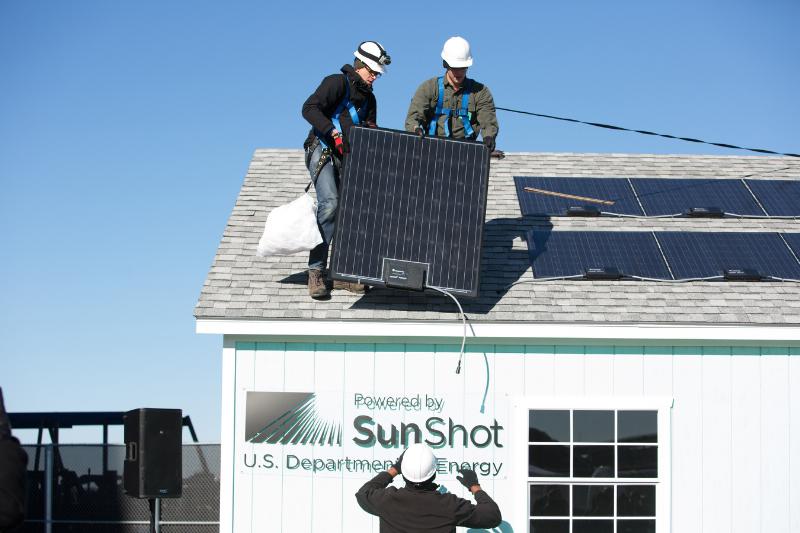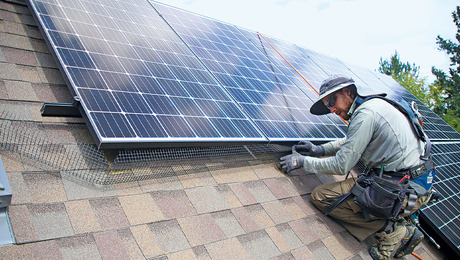
Although it won’t be commercially available for a couple of years, a photovoltaic (PV) system under development by a Boston-based research lab is designed for installation and connection to the grid by any motivated DIYer in less than a day.
In a press release, The Fraunhofer Center for Sustainable Energy Systems (CSE) said it had demonstrated the installation of its Plug-and-Play PV System. Technicians completed the job in an hour. (You can see how the demonstration went on on Twitter at #FhCSESolar.)
The U.S. Department of Energy’s SunShot Initiative is paying for the research and development project, which CSE said would help bring the cost of solar electricity from $4 per installed watt to $1.50 per watt by 2020, a reduction of more than 60%. The lab said the system “addresses all aspects of the solar purchasing and installation process” by simplifying interconnection, permitting, and inspection.
CSE Director Dr. Christian Hoepfner said in the release the lab is focused on getting technologies such as clean energy into the hands of consumers.
“The Plug and Play system is centered around ease of use and installation to encourage people to adopt solar,” the statement said. “Once commercially available, homeowners will be able to go to their local building supply stores, purchase the PV systems, and install them in less than 10 hours — as easily as installing a washer/dryer combination.”
Making installation as simple as possible
Hoepfner said in a telephone interview the panels use “pretty traditional” crystalline-silicone technology. The panels used in the demonstration have a rated capacity of 175w each, small and light enough for someone to carry under an arm, although they also could be produced with a higher capacity than that.
They’re attached to the roof with an adhesive made by Royal Adhesives.
Developers had three major problems to solve, Hoepfner said: making the wiring on the rooftop and down to the side of the house as simple and safe as possible, connecting the panels to the electric meter, and simplifying the interconnection process — that is, hooking it up to the grid.
“We put a lot of thinking into this and in particular a lot of focus on making it safer so that it is basically impossible to accidentally kill yourself on any high voltage on the roof,” he said.
Panels would be connected to the house wiring via a PV socket installed behind the utility’s meter. A licensed electrician or utility worker would have to pull the meter (not something a homeowner could legally do), install a “meter collar” incorporating the socket, and then re-install the meter, a process Hoepfher said should take all of about 10 minutes.
Once the socket was installed, the homeowner shouldn’t need any additional help from a professional. It would be a matter of going to a retail store, buying the panels and installing them.
Once the panels have been commissioned, the system sends data to the local building officials and the utility, “automating the permitting, inspection and interconnection process,” according to CSE.
Solving one of solar’s most pressing problems
Assuming it gets to market, the Plug and Play system would address one of the biggest obstacles to a wider adoption of residential PV — the relatively high “soft” costs of permitting, installation, inspections, and other non-hardware components.
In a 2013 report, The Rocky Mountain Institute said hardware costs have dropped sharply since 2008 while progress on bringing down soft costs has been “particularly unimpressive.”
The report said in part: “Australia and Germany, both with healthy solar markets, have residential solar costs at about half that of the U.S. What’s more, nearly every penny of the savings in upfront capital costs in those countries is due to much lower soft costs. In brief, soft costs have become a national embarrassment.
“Framed more concretely, in the U.S. you could give away solar panels for free and still end up paying nearly $20,000 for a residential system. That may seem absurd, but it’s our current reality.”
Northeast Utilities likes the program
Electric utilities haven’t always been eager to see new residential PV systems. Some have complained that as more homeowners install solar and reduce their purchase of electricity, non-solar households have to pick up more of the cost of maintaining the grid. Lower sales of electricity also could lower earnings for shareholders in publicly traded utilities.
That could be a potential rub if homeowners suddenly have an even easier, cheaper path toward installing PV. CSE, however, said it has been working with several New England utilities, including Northeast Utilities, National Grid and Green Mountain Power, as it developed the Plug and Play system.
And Northeast responded positively to the demonstration project.
“We at Northeast Utilities see this program as incredibly important because it not only addresses installation barriers, but also simplifies the interconnection process,” Penni Conner, Northeast’s senior vice president and chief customer officer, said in the CSE statement.
“These systems make solar adoption a less complicated and time-consuming process for our customers and easier for us to bring new solar onto our systems. Our customers are going to have easier access to solar, helping us support a more sustainable energy future.”
Why have utilities embraced Plug and Play?
“Most people and most utility executives would agree there are big changes ahead and a lot of uncertainty about that and how it will evolve,” Hoepfner said of distributed solar generation. “On the practical level, however, utilities are required to do this already… Once you do this and the political decision has been made to do this, either voluntarily or involuntarily, then you want to make this as easy as possible.”
Another reason is that Plug and Play would reduce the number of PV systems hooked up without utilities knowing about it. That may not be a huge problem now, Hoepfner said, but as solar becomes cheaper, more people will be tempted to buy panels and install them with or without utility permission.
The CSE Plug and Play, however, can’t be energized unless the utility has actively given its permission to interconnect. That feature would give utilities an “unprecedented level of insight” into how much solar was actually on their grid. Utilities would like that, too.
Don’t go shopping quite yet
Hoepfner said he’s already getting calls from installers who want to know where they can buy the equipment, but it’s two years or more away from store shelves.
In 2015, CSE hopes to move the system from the “technology demonstration” that took place earlier this month to a “commercially ready prototype,” but it would be 2017 before all of the pieces were in place for retail sales.
It’s not just a single product that needs more complete development, Hoepfner said, but the framework in which a standard is developed, allowing a lot of companies to take part and offer plug-and-play products. That’s going to take time.
Fine Homebuilding Recommended Products
Fine Homebuilding receives a commission for items purchased through links on this site, including Amazon Associates and other affiliate advertising programs.

Handy Heat Gun

8067 All-Weather Flashing Tape

Reliable Crimp Connectors

A solar electric system in kit form would allow homeowners to install their own panels and connect them to the grid as easily as installing a new appliance. The system, currently under development, is still a few years away from commercial availability.



























View Comments
Thanks for posting, Scott. It's great to see that the term "Plug & Play" resurrected again from the old days of PC's and peripherals. As a DIY type of guy, I really like this idea, but I'm also concerned about the "average" consumer trying to do this on their own. I know plenty of people - men and women - who don't have the first idea how to install a washer / dryer or even a piece of furniture from IKEA...and that's happening in the safety of their living rooms. I appreciate that they are working to make it "basically impossible to accidentally kill yourself" but in a society where people sue companies over hot coffee and plastic bags used for packaging have to have a message that tells kids & parents "this is not a TOY" so that they don't suffocate, I worry that something this touchy will never make it passed the lawyers in order to make it to market at an affordable price. I am glad that there are companies who are working on simplifying these 'alternatives' though...a rising tide (of knowledge) raises all ships.
Sustainably yours,
Tim King
Freelance Writer & Marketing Communications
Scarborough, Maine.
https://www.linkedin.com/in/timkinglinkedin
Be true to your work, your word and your friend.
~ Henry David Thoreau